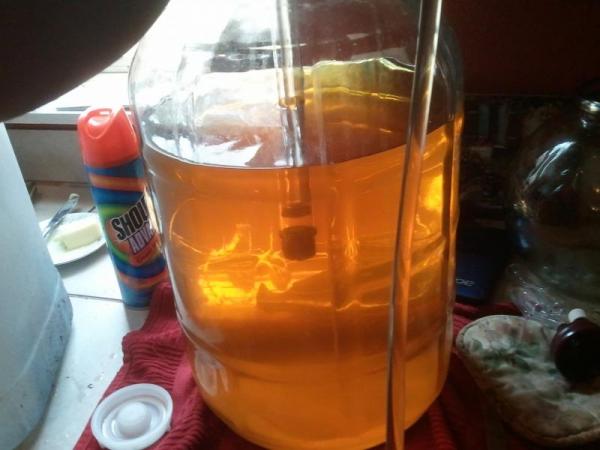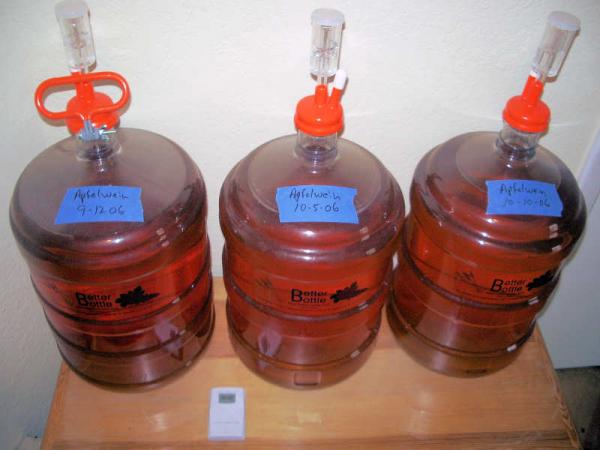I was first introduced to Apfelwein in Darmstadt, Germany at a friend's party. It's a local hard cider drink from the Frankfurt area, but is now famous throughout the world and I enjoyed it for 5 years back in the early 90's.

I have been homebrewing since 1987, but did not bother during the 5 years of living in beer heaven. When I returned to the United States, I began to gather up the needed equipment to make good beer again and I thought about replicating the dry, tart beverage of Apfelwein. The Internet was forever changing the way homebrewers shared their successes and failures and information was plenty.
I started off with Apple Juice and Montrachet wine yeast. I added some corn sugar to boost the alcohol content, and found out by accident that it helped dry out the cider, making it even closer to the original Frankfurter Apfelwein . The rest is history.

The recipe was posted on Homebrewtalk.com just over 8 years ago and it has garnered over 2.2 million views and over 12,000 responses. Google "Apfelwein Recipe" and it's the number one return.
Over the years, I have received hundreds of private messages from folks who have told me that Apfelwein was the deciding factor in their start of homebrewing beer. The ease of making a batch of Apfelwein and the subsequent success of enjoying the finished product encouraged many a newbie into the next step of homebrewing. Many jumped head first into All Grain brewing.

Making Apfelwein is as easy as mixing juice, sugar, and yeast, plus a lot of patience. In the process, people learn many of the basic steps needed for homebrewing, but without having to buy all the equipment or deal with what at first glance can be a complicated process.

Apfelwein makers learn the proper way to clean and sanitize fermentation vessels, racking equipment, and bottles. They also learn how to bottle and carbonate a beverage. Finally, they learn the value of patience and the impact it has on the finished product. These are basic, yet very important skills needed to make good beer.

I am very happy that the Apfelwein recipe has helped so many homebrewing wannabe's get off the fence and start a new hobby that results in fantastic libations!
Prost!
EdWort
***
Award Winning Apfelwein Recipe (German Hard Cider)
Apple Wine Recipe
1. Sanitize the carboy, airlock, funnel, stopper or carboy cap.
2. Open one gallon bottle of apple juice and pour half of it into the carboy using the funnel.
3. Open one bag of Dextrose and carefully add it to the now half full bottle of apple juice. Shake well.
Repeat Steps 2 and 3, then go to step 5.
4. Pour in the mixture of Apple Juice and Dextrose from both bottles into the carboy.
Add all but 1 quart of remaining 3 gallons of apple juice to the carboy.
5. Open the packet of Montrachet Yeast and pour it into the neck of the funnel.
Use the remaining quart of juice to wash down any yeast that sticks. I am able to fit all but 3 ounces of apple juice into a 5 gallon Better Bottle. You may need to be patient to let the foam die down from all shaking and pouring.
6. Put your stopper or carboy cap on with an airlock and fill the airlock with cheap vodka. No bacteria will live in vodka and if you get suckback, you just boosted the abv.
There's no need to worry about filling up a carboy so full when you use Montrachet wine yeast. There is no just, just a thin layer of bubbles . I'm able to fit all but 4 oz. of my five gallons in the bottle. Ferment at room temperature.
It will become cloudy in a couple of days and remain so for a few weeks. In the 4th week, the yeast will begin to drop out and it will become clear. After at least 4 weeks, you can keg or bottle, but it is ok to leave it in the carboy for another month or so. Racking to a secondary is not necessary.
It ferments out very dry (less than 0.999, see here) Apfelwein really improves with age, so if you can please let it sit in a carboy for up to 3 months before bottling or kegging, then let it sit even longer.


I have been homebrewing since 1987, but did not bother during the 5 years of living in beer heaven. When I returned to the United States, I began to gather up the needed equipment to make good beer again and I thought about replicating the dry, tart beverage of Apfelwein. The Internet was forever changing the way homebrewers shared their successes and failures and information was plenty.
I started off with Apple Juice and Montrachet wine yeast. I added some corn sugar to boost the alcohol content, and found out by accident that it helped dry out the cider, making it even closer to the original Frankfurter Apfelwein . The rest is history.

The recipe was posted on Homebrewtalk.com just over 8 years ago and it has garnered over 2.2 million views and over 12,000 responses. Google "Apfelwein Recipe" and it's the number one return.
Over the years, I have received hundreds of private messages from folks who have told me that Apfelwein was the deciding factor in their start of homebrewing beer. The ease of making a batch of Apfelwein and the subsequent success of enjoying the finished product encouraged many a newbie into the next step of homebrewing. Many jumped head first into All Grain brewing.

Making Apfelwein is as easy as mixing juice, sugar, and yeast, plus a lot of patience. In the process, people learn many of the basic steps needed for homebrewing, but without having to buy all the equipment or deal with what at first glance can be a complicated process.

Apfelwein makers learn the proper way to clean and sanitize fermentation vessels, racking equipment, and bottles. They also learn how to bottle and carbonate a beverage. Finally, they learn the value of patience and the impact it has on the finished product. These are basic, yet very important skills needed to make good beer.

I am very happy that the Apfelwein recipe has helped so many homebrewing wannabe's get off the fence and start a new hobby that results in fantastic libations!
Prost!
EdWort
***
Award Winning Apfelwein Recipe (German Hard Cider)
Apple Wine Recipe
- Placed 1st in the Cider & Apple Wine category at the BJCP sanctioned Alamo Cerveza
- 2nd place for Best of Show for the main category of Meads & Ciders
- 5 Gallons 100% Apple Juice (No preservatives or additives) I use Tree Top Apple Juice
- 2 pounds of dextrose (corn sugar) in one pound bags
- 1 five gram packet of Montrachet Wine Yeast
- 5 Gallon Carboy
- Carboy Cap or Stopper with Airlock
- Funnel
1. Sanitize the carboy, airlock, funnel, stopper or carboy cap.
2. Open one gallon bottle of apple juice and pour half of it into the carboy using the funnel.
3. Open one bag of Dextrose and carefully add it to the now half full bottle of apple juice. Shake well.
Repeat Steps 2 and 3, then go to step 5.
4. Pour in the mixture of Apple Juice and Dextrose from both bottles into the carboy.
Add all but 1 quart of remaining 3 gallons of apple juice to the carboy.
5. Open the packet of Montrachet Yeast and pour it into the neck of the funnel.
Use the remaining quart of juice to wash down any yeast that sticks. I am able to fit all but 3 ounces of apple juice into a 5 gallon Better Bottle. You may need to be patient to let the foam die down from all shaking and pouring.
6. Put your stopper or carboy cap on with an airlock and fill the airlock with cheap vodka. No bacteria will live in vodka and if you get suckback, you just boosted the abv.
There's no need to worry about filling up a carboy so full when you use Montrachet wine yeast. There is no just, just a thin layer of bubbles . I'm able to fit all but 4 oz. of my five gallons in the bottle. Ferment at room temperature.
It will become cloudy in a couple of days and remain so for a few weeks. In the 4th week, the yeast will begin to drop out and it will become clear. After at least 4 weeks, you can keg or bottle, but it is ok to leave it in the carboy for another month or so. Racking to a secondary is not necessary.
It ferments out very dry (less than 0.999, see here) Apfelwein really improves with age, so if you can please let it sit in a carboy for up to 3 months before bottling or kegging, then let it sit even longer.



